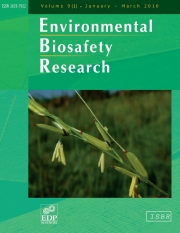Crossref Citations
This article has been cited by the following publications. This list is generated based on data provided by
Crossref.
Madsen, Kathrine Hauge
and
Sandøe, Peter
2005.
Ethical reflections on herbicide‐resistant crops.
Pest Management Science,
Vol. 61,
Issue. 3,
p.
318.
Devos, Yann
Reheul, Dirk
De Waele, Danny
and
Van Speybroeck, Linda
2006.
The interplay between societal concerns and the regulatory frame on GM crops in the European Union.
Environmental Biosafety Research,
Vol. 5,
Issue. 3,
p.
127.
Jensen, Karsten Klint
2006.
“Conflict over Risks in Food Production: A Challenge for Democracy”.
Journal of Agricultural and Environmental Ethics,
Vol. 19,
Issue. 3,
p.
269.
Enick, O.V.
and
Moore, M.M.
2007.
Assessing the assessments: Pharmaceuticals in the environment.
Environmental Impact Assessment Review,
Vol. 27,
Issue. 8,
p.
707.
Aslaksen, Iulie
and
Ingeborg Myhr, Anne
2007.
“The worth of a wildflower”: Precautionary perspectives on the environmental risk of GMOs.
Ecological Economics,
Vol. 60,
Issue. 3,
p.
489.
Madsen, Kathrine H.
and
Sandøe, Peter
2008.
Agrobacterium: From Biology to Biotechnology.
p.
677.
Houghton, J.R.
Rowe, G.
Frewer, L.J.
Van Kleef, E.
Chryssochoidis, G.
Kehagia, O.
Korzen-Bohr, S.
Lassen, J.
Pfenning, U.
and
Strada, A.
2008.
The quality of food risk management in Europe: Perspectives and priorities.
Food Policy,
Vol. 33,
Issue. 1,
p.
13.
Devos, Yann
Maeseele, Pieter
Reheul, Dirk
Van Speybroeck, Linda
and
De Waele, Danny
2008.
Ethics in the Societal Debate on Genetically Modified Organisms: A (Re)Quest for Sense and Sensibility.
Journal of Agricultural and Environmental Ethics,
Vol. 21,
Issue. 1,
p.
29.
Mauro, Ian J.
McLachlan, Stéphane M.
and
Van Acker, Rene C.
2009.
Farmer knowledge and a priori risk analysis: pre-release evaluation of genetically modified Roundup Ready wheat across the Canadian prairies.
Environmental Science and Pollution Research,
Vol. 16,
Issue. 6,
p.
689.
Cohen, Benjamin R.
2009.
The once and future georgic: agricultural practice, environmental knowledge, and the place for an ethic of experience.
Agriculture and Human Values,
Vol. 26,
Issue. 3,
p.
153.
Jackson, Lee Ann
and
Jansen, Marion
2010.
Risk assessment in the international food safety policy arena. Can the multilateral institutions encourage unbiased outcomes?.
Food Policy,
Vol. 35,
Issue. 6,
p.
538.
Myhr, Anne Ingeborg
2010.
The Challenge of Scientific Uncertainty and Disunity in Risk Assessment and Management of GM Crops.
Environmental Values,
Vol. 19,
Issue. 1,
p.
7.
Goven, Joanna
and
Morris, Carolyn M.
2012.
Regulating Biopharming: The Prism of Farmer Knowledge.
Science as Culture,
Vol. 21,
Issue. 4,
p.
497.
Devos, Yann
Sanvido, Olivier
Tait, Joyce
and
Raybould, Alan
2014.
Towards a more open debate about values in decision-making on agricultural biotechnology.
Transgenic Research,
Vol. 23,
Issue. 6,
p.
933.
Hartley, Sarah
Gillund, Frøydis
van Hove, Lilian
Wickson, Fern
and
Marris, Claire
2016.
Essential Features of Responsible Governance of Agricultural Biotechnology.
PLOS Biology,
Vol. 14,
Issue. 5,
p.
e1002453.
Binimelis, Rosa
and
Myhr, Anne
2016.
Inclusion and Implementation of Socio-Economic Considerations in GMO Regulations: Needs and Recommendations.
Sustainability,
Vol. 8,
Issue. 1,
p.
62.
Redford, Kent H.
Brooks, Thomas M.
Macfarlane, Nicholas B.W.
and
Adams, Jonathan S.
2019.
Genetic frontiers for conservation: an assessment of synthetic biology and biodiversity conservation: technical assessment.
Kokotovich, Adam E
Delborne, Jason A
Elsensohn, Johanna
Burrack, Hannah
and
Morisette, Jeffrey
2020.
Emerging Technologies for Invasive Insects: The Role of Engagement.
Annals of the Entomological Society of America,
Vol. 113,
Issue. 4,
p.
266.
Montoliu, Lluis
2023.
Transgenesis.
Vol. 2631,
Issue. ,
p.
1.
Hartley, Sarah
Kokotovich, Adam
Devos, Yann
and
Mumford, John
2023.
Engagement on risk assessment for gene drive mosquitoes by EFSA and Target Malaria.
Environmental Science & Policy,
Vol. 142,
Issue. ,
p.
183.

